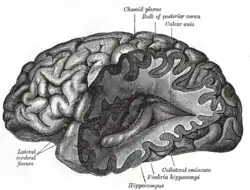Neurobiotics
Neurobiotics is a loose term without strict definition referring to the study of the nervous system in conjunction with technology.[1] Of particular importance in the field of neurobiotics is the brain and its direct interaction with computer systems, as well as methods of externally simulating the brain. Also, a large branch of neurobiotics commonly called neurosimulation, concerns the attempt to produce strong AI by combining neural networks and the basics of psychology.[2]
History
The term neurobiotics has no documented first use and several sources claim to have 'coined' the term.[3][4] But most likely the term has been invented countless times due to both its Latinate nature and the way the roots have been used in other terms. Neur- meaning nerve and biotic meaning of or related to life.[5] The technological overtones behind neurobiotics probably simply come from the fact that the term sounds modern, most easily explained by memetic theories.
The term is often used only to refer to individual projects or companies, and most who use it are unaware that the term is commonly used.[4] There is no official definition for the term, and since it is frequently reinvented by people, it can refer to a wide range of ideas, concepts, studies and goals. The most definitive source for the term is probably from the private research company NDT Neurobiotics with branches in the University of Colorado at Boulder and Carnegie Mellon. NDT Neurobiotics' primary focus is the creation of strong AI, with a stated company goal of passing the Turing test. They also invest significantly into studies that they hope will lead to direct neural interface.[6]
Magical connotations
The term neurobiotics has been used with 'magical' overtones, referring to areas such as mind reading and animating inanimate objects. There are also connection concerning the idea that time is relative (in the non-Einsteinian meaning) and that life (and nerves) can control time to an extent. These uses are nonstandard and probably have no connection to the scientific uses.
Potential technology
The study of neurobiotics is only very loosely bound, and the technology far off. Much of the technology that advocates hope for are only loose concepts that seem closer to the realm of science fiction than science. The main technological areas that neurobiotics targets are direct neural interfaces, strong AI and neurostimulators which affect previously inaccessible areas of our cognition such as creativity and motivation. Virtual reality, created through direct stimulation of the input nerves and directly reading the output nerves is also a commonly hoped for technology.
Active Research
Thousands of research labs are probing areas that could be included in the umbrella of neurobiotics.[7] Although very few use the term neurobiology. Dr. Jeffrey R. Johnson, chiropractor, has used the term for his practice since 2002, but uses a nonstandard definition.[3] NDT Neurobiotics, founded in 2000, also uses the term and with one of the largest budgets in the United States,[6] is probably the leader in the field (although data from NDT Neurobiotics has yet to be released). Allan Snyder at the Centre for the Mind in Australia is working on increasing humans 'savant' skills by "zapping their brain with transcranial magnetic stimulation (TMS)."[4] He also coined the term champion mindset.
Morality
Neurobiotics isn't currently in the public spotlight, but if and when it is it will likely be bombarded with the same moral qualms as genetic engineering as well as xenophobia. The question of whether or not we have the right to tamper with our brains as well as the question of whether or not various forms of strong AI have the right to live have been frequented by science fiction writers, but will probably be a long time before hitting the public forums. Proponents of neurobiotics, such as James Mikal, are hoping that by the time technological achievements can be made, the "...tides of xenophobia and conservatism will have turned."[6]
The future
The feasibility of neurobiotics has yet to be proven, but if key research breakthroughs happen, it is expected that neurobiotics will be one of the biggest industries around 2070, with everything from entertainment to investment being handled by various neurobiotic technologies.[1]
References
- Kandel, Eric R. (2000). Principles of Neural Science. 4th Ed. McGraw-Hill Medical. ISBN 0-8385-7701-6
- Enquist, Magnus. (2005). Neural Networks and Animal Behavior. Princeton University Press. ISBN 0-691-09633-3
- travel media shopping computers hardware at neurobiotics.com
- "Science Museum | Antenna | NEURObotics...the future of thinking?". Archived from the original on 2010-05-07. Retrieved 2010-05-07.
- Greek and Latin base transition page
- http://www.ndtneurobiotics.com
- Eslinger, Paul J. (2005). Neuropsychological Interventions: Clinical Research and Practice. The Guilford Press. ISBN 1-59385-163-4
